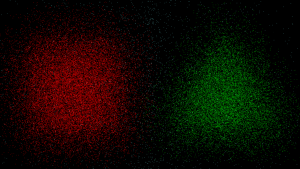The Synesthetic Speakeasy – Cycle 1 Proposal
Posted: October 9, 2016 Filed under: Uncategorized Leave a comment »For our first cycle I’d like to explore narrative composition and storytelling techniques in VR. I’m interested in creating a vintage speakeasy / jazz lounge environment in which the user passively experiences the mindsets of the patrons by interacting with objects that have significance to the person they’re associated with! This first cycle will likely be experimentation with interaction mechanics and beginning to form a narrative.
Peter’s Produce Pressure Project (2)
Posted: October 9, 2016 Filed under: Uncategorized Leave a comment »For our second pressure project, I used an Arduino (similar to a Makey-Makey) to allow for users to interact with a banana and orange as vehicles for generating audio. As the user touches a piece of fruit, a specific tone begins to pulse. Upon moving that fruit, it’s frequency increases with velocity. Then, if both pieces of fruit move quickly enough, geometric shapes on-screen explode! Once you let go of them, the shapes will reform into their geometric representations.
Our class’s reaction to the explosion was awesome; I wasn’t expecting it to be that great of a payoff 🙂
cycle 1 plans
Posted: October 4, 2016 Filed under: Uncategorized Leave a comment »Computer vision which tracks movement of 1 (maybe two) people moving in different quadrants (or some other word that doesn’t imply 4) of the video sensor (eyes or maybe use kinect to work with depth of movement as well), such that different combinations of movement trigger different sounds. (ie, lots of movement in upper half and stillness below triggers buzzing, reverse triggers a stampede or alternating up and down distal movement triggers sounds of wings flapping…. more to come if I can figure that out.
Pressure Project 2
Posted: October 4, 2016 Filed under: Uncategorized Leave a comment »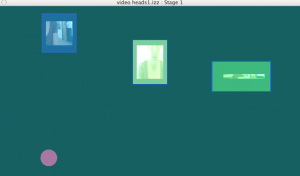
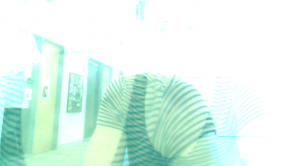

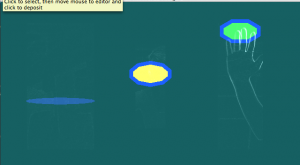
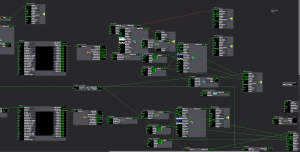 https://osu.box.com/s/7evtez7zjct0hg2ws4o9g2zlj04mb0qg
https://osu.box.com/s/7evtez7zjct0hg2ws4o9g2zlj04mb0qg
I started with a series of makey makey water buttons as a trigger for sounds and wanting to come up with different sequences of triggering to jump to different scenes. So if you touched the blue bowl of water then the green then yellow twice and then green again, through the calculator and inside range actors, you get moved to another scene. The made up the scenes trying to create variations on the colors and shapes that were part of the first scene, save for one, that was just 3 videos of the person interacting fragmented and layered with no sound. The latter was to make a interruption of sorts. BUT…. in practice, people triggered the water buttons so quickly that scenes didn’t have time to develop and the motion detection and interpretation from some of the scenes (affecting shape location and sound volume), didn’t become part of the experience. Considering now how to provide a frame for those elements to be more immediately explored, to slow people down in engaging with the water bowls whether via text or otherwise AND the possibility of a trigger delay to make time between each action.
PP2_Taylor__E.T. Touch/Don’t Touch__little green light…
Posted: October 4, 2016 Filed under: Assignments, Pressure Project 2, Taylor Leave a comment »So… I still don’t think my brightness component is firing correctly but feel free to try it out by shining your flashlight at the camera to see if it works for you. pp2-taylor-izz
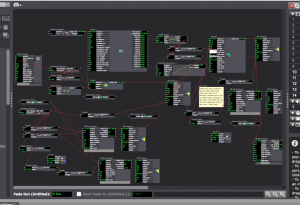
I felt that the Makey Makey was just as limiting as it was full of possibilities… not the biggest fan, maybe if the cords were longer and grounding simpler (like maybe I could have just made a bracelet)
So, I believe the first response to my system from the peanut gallery was “What happens if you touch them at the same time”… my answer to this, I don’t know… it probably will explode your computer, but feel free to try.
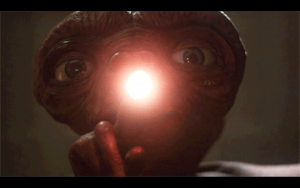
other responses: Alice and wonderland feel, grounding is reminiscent of a birthday hat, voyeuristic — watching the individual interact with the system (and seeing their facial reactions from behind).
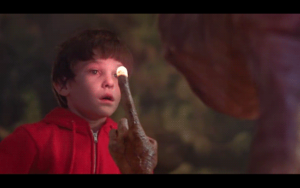
I wonder what reactions would be like if people interacted with it in singular experiences… like just walking up not really knowing anything. I was thinking about the power of the green light, and if this would compel people to follow or break the rules (our class is always just looking to break some shit – oh that’s what it does…what if…). All of the E.T. references came about from me just thinking touch — what’s a cool touch?
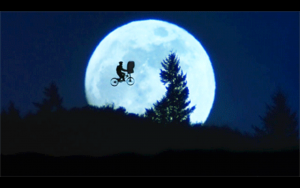
And the whole thing was a bastardization of a patch I was working on for my rehearsal… not done yet but here is the beginning of that.pp2-play4pp-izz
Taxonomies
Posted: September 27, 2016 Filed under: Reading Responses 1 Comment »The author uses taxonomication in order to create a framework to diagramize the different variables of interactive performances. Diagrams show the possible connections between different elements and makes it possible to break into steps. The article is a good source to learn about the media usage with key terms in order to distinguish the purpose of different channels
“For example, we might chart the array of interactions associated with a single dramatic function, such as dramatic media or coextensive media; or, alternatively, we may sort the interactions according to time and space and treat dramatic function as a subsidiary variable. The taxonomy is entirely nonhierarchical. No combination of variables is more fundamental than any other, and none of the variables or perspectives is privileged.” (pp. 123)
The taxonomy provides a clarification to finalize the endless possibilities of interaction. Therefore, it is possible to define the hierarchy of variables, in order to break the work into steps. Also the role of the audience (and performer) within the work can be defined in various ways.
Use of media as an autonomous object or instrument is a choice of the designer. Being aware of the distinction between the channels and consideration of time and space brings an advanced level of consciousness to work.
Meta EVERYTHING – Performance and Media Taxonomy
Posted: September 27, 2016 Filed under: Uncategorized Leave a comment »I wanted to share a video with you all! A virtual reality researcher recorded himself with Kinects interacting with a computer program, entered that recording in the present, and interacted with what his past self was creating. The interaction is a here / there / virtual, now / then, and actor / prop / mirror / costume all bundled into one! It’s fascinating and I hope you all enjoy 🙂
Cheers,
Peter
Pressure Project 2
Posted: September 23, 2016 Filed under: Alex Oliszewski, Announcements, Pressure Project 2 Leave a comment »Take the same constraints from PP1 and add the following to the mix.
The generative experience should be intended for an individual.
The experience must include sound.
The experience must include a physical interface.
Please refer to PP1 to insure to include those details as well.
-Alex
Just Another Thing #2
Posted: September 22, 2016 Filed under: Uncategorized Leave a comment »I refound this today and though it is a bit old I re-fell in love. The Wilderness Downtown is not quite AR but not not AR. There is a magic in seeing things that are part of you on a screen, it somehow validates one’s experience as a human. A frame adds worth, which explains the grandiose self-portrait or even the home film. Anyways,
Anyways, so then I looked Chris milk up and found a TED talk (because there is a TED talk on everything). The talk is basically an exploration of his artistic trajectory. But he also talks about VR film and some fairly compelling storytelling applications.
